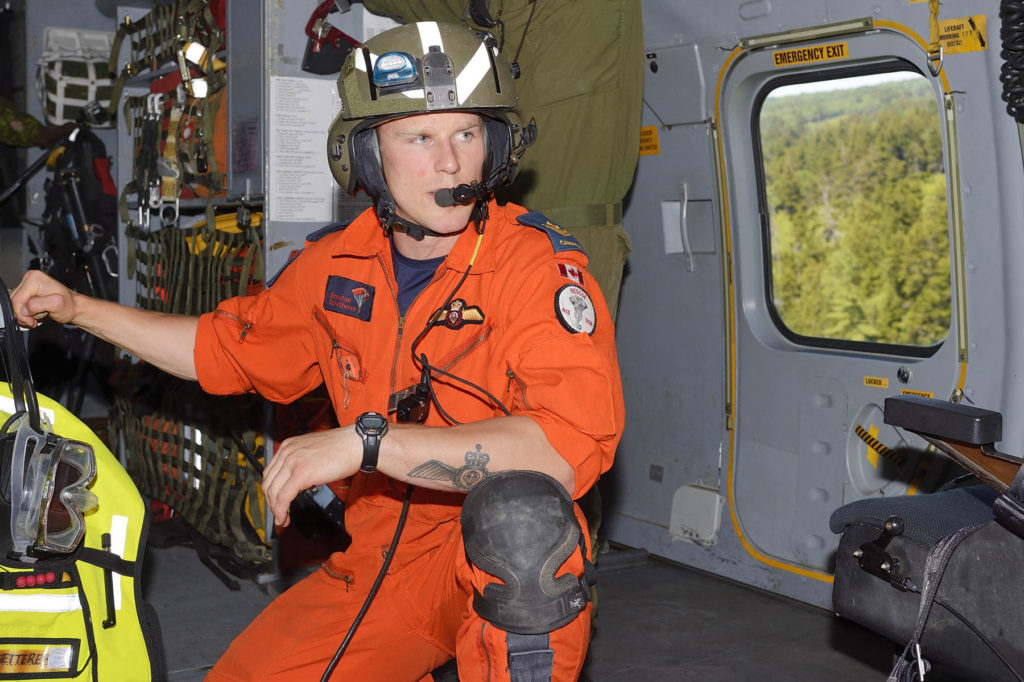Estimated reading time 6 minutes, 33 seconds.
Sgt Brandon Schetterer, a search and rescue technician (SAR tech) with 17 Wing Winnipeg, Manitoba’s 435 Transport and Rescue Squadron, says his “spidey” senses were tingling at the 75th Para Rescue Reunion of the Para Rescue Association of Canada, held Sept. 6 to 9, 2019, in Winnipeg.

WO Joel Manaigre, Schetterer’s supervisor, had asked his colleague to volunteer at the Sept. 8 dinner, knowing that the sergeant was always up to helping out. Instead of having a volunteer position that evening, however, Schetterer was actually an award winner who was presented with the 2019 SAR Tech of the Year award.
“I knew that I was going to help out a bit, but I wasn’t sure [in exactly what capacity],” he said. “I was just wearing a T-shirt and normal pants. Then, my wife came on stage just before they presented it. It was a real shock. Holy Smokes!”
The SAR Tech of the Year award recipient is selected from the search and rescue occupation, based on his or her performance in the Canadian Armed Forces (CAF), the occupation itself, his or her interactions with the community and families, and his or her role with the SAR family and home life.
Schetterer was nominated for the award by Manaigre, the search and rescue technician lead at 435 Training and Rescue Squadron, on behalf of the squadron. As noted by Manaigre, “[Sergeant Schetterer’s] performance over the past year truly reflects and promotes the core values of the SAR tech trade, through his steadfast professionalism, dedication, and teamwork.”
Two events in particular exemplified Schetterer’s outstanding performance and leadership.
The first involved the rescue of an 11-month-old baby from a remote hunting camp in northern Ontario that was inaccessible by road, boat, or snowmobile. The infant had been unwell with a fever for the previous two weeks, and had been progressively worsening in the days leading up to the rescue. The infant stopped taking in foods and liquids, and had become lethargic with poor colour; the parents had also run out of medicine for their child.
After an exacting nighttime parachute descent into a forest, which included having to remove his helmet after a branch lodged between his helmet and his head, Schetterer and his teammate stabilized the infant and waited with the family to monitor the health of the baby. After several hours, a medical evacuation was conducted by helicopter, but not before the two rescuers had to cross some very difficult terrain with their precious cargo to get to the pickup location.
The second involved two hikers stranded on Gros Morne Mountain, in Newfoundland; one of the hikers was injured, and both were hypothermic. Due to inclement weather, the CH-149 Cormorant helicopter was unable to access the location of the two hikers.
After discussion with his fellow crew members and Parks Canada staff, Schetterer received authorization for the helicopter to land at the base of the mountain, and to go to the location of the two hikers along with team member MCpl Nigel Donley and two Parks Canada staff. They completed the challenging, normally five-hour hike, at nighttime in severe weather with snow on the ground, in three hours.The two SAR techs and their companions ran up the mountain.
At the scene, they stabilized their patients. Due to the continuing inclement weather, Schetterer and the others had to wait it out until the conditions improved. After several hours, the clearing weather finally allowed for a rope rescue.
The rope rescue itself was problematic due to the steep terrain. The team, now assisted by additional ground search and rescue personnel who had hiked in when the weather had marginally improved, climbed down the mountain with their patients in four challenging rope descents.
For the descents, a “work” station was established, anchoring the rope to the mountain, then lowering the patients in a Sked–a foldable stretcher resembling a crazy carpet that assists in traversing rough terrain more readily–as well as the rest of the rescue team. This feat was repeated four times until the patients and responders were able to arrive at a location suitable for the helicopter rescue off of the mountain. Schetterer coordinated the multiple aircraft, Parks Canada, and ground SAR crews to extract the patients, and the SAR personnel involved in the rescue.
In total, Schetterer and his team spent 11 hours on the mountain, and travelled 24 kilometres.
Schetterer, a native of Victoria, B.C., who calls himself an avid outdoorsman, was a civilian paramedic and wildfire fighter prior to joining the Canadian Armed Forces. “I applied and went through the selection, and was picked to do the training,” he said. “I had never heard of a job that unique, I never even did much research into military trades, but once I heard about SAR techs, I said, ‘that trade is definitely for me.’ It encompassed a lot of the things I wanted to do and enjoy doing.”
He went through the intensive 11-month SAR tech course at the Canadian Forces School of Search and Rescue, located at 19 Wing Comox in British Columbia.
That just gives you the basic tools to learn the job, but once you get to the unit you’re learning how to use those skills on the aircraft,” Schetterer said. “They give you the pieces, and you learn how to use those tools and to effect a rescue. It’s a tremendous honour, and is a part of the pride I feel in being part of this organization. This job makes you very happy to be part of the RCAF. We’ve got a great group of guys here.”